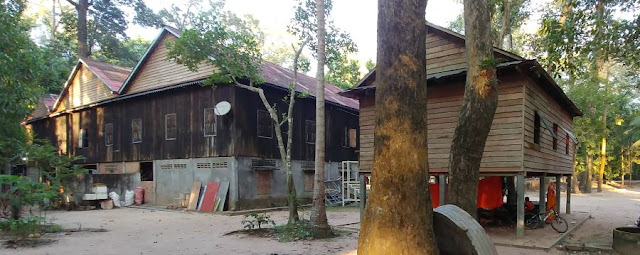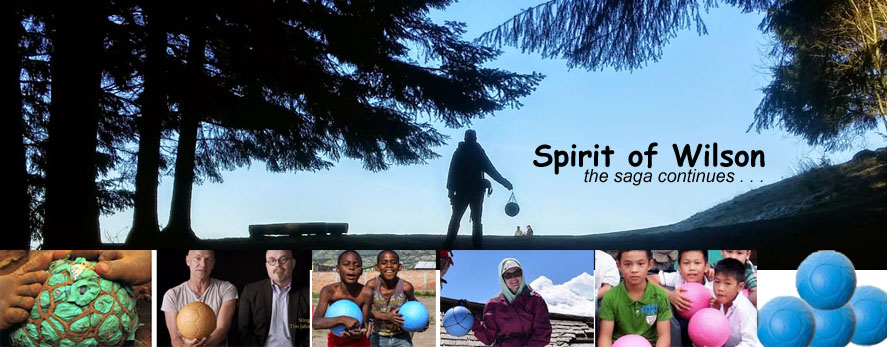 |
| Photo by David Biviano |
Man walks into a jungle. Big, thick jungle. Then he runs into a wall. A big, big long wall. Does this sound like the beginning of a joke? Are you waiting for the punchline? There is no punchline. The man has just discovered one gargantuan religious structure -- the largest religious structure ever built. Welcome to Angkor Wat.
This is a story I've been waiting to share. One of the reasons I went to Cambodia this year -- aside from seeing how my village was doing and delivering unbreakable soccer balls -- was to see this incredible structure and write about it. Give that up. You can only see so much of this and other temples before your brain erupts. And I can only begin to tell you about Cambodia's religious architecture. But I recommend you spend some time on Google and read about these places. It will be time well spent.
I took a bus to Siem Reap, the major city by Angkor Wat, to meet up with my friend, David Biviano, who offered to set me up with a driver and trained guide, two young men who were with him when he operated an orphanage in Siem Reap. They are now grownups, but they still treat him as if he were their dad. Before we took in Angkor Wat, we decided to go to the headwaters of the Siem Reap river, which provided an unforgettable glimpse on what it means to be a pagan, a concept I am gradually getting my head around.
Linga lore
The outing to the headwaters involved an hour's drive out of town, where we entered a jungle park by hiking up, most of the way, what likely was a dry waterfall, awaiting the return of the monsoons. The earth under feet was an extremely fine reddish sand, next to large blocks of sandstone -- the type of stone likely used to build Angkor Wat. Our driver, San Lay, stayed with the vehicle while David and our guide, Phalla, went in search for what lay in wait for us at the Siem Reap headwaters.
 |
Phalla (pronounced "Paula") displayed the strength of a really long jungle vine by swinging on it.
|
 |
Yes, that's a vine, and it runs for a long way.
|
 |
This unusual vine formation is called a "monkey ladder."
|
 |
Huge sandstone boulders shed fine sand on the trail that could be perilous for its dry slickness.
|
I came into contact with my first linga at the headwaters, and how impressive they were: some barely the size of the back of my hand, and one a few feet across. Oh, I should explain. The linga, as I understand it, is the male organ of the God Shiva. The Yoni is the vagina or womb of Oma, Shiva's wife. The picture below is a cutaway of them forming, as we Americans might say, a more perfect union.
There's a lot of this going on at the Siem Reap headwaters. To wit, the photo below, which shows a whole lot of linga gathered together.
 |
These are not stepping stones to be walked on. These are Shiva's linga.
|
In the photo below you see how the linga look from the side.
 |
So why do so many linga linger here?
|
Why so many linga? It's the economy, stupid. These are here to make the rice grow. Cambodia is built something like a cup, and in that bowl is grown an enormous amount of rice. As the waters from the Siem Reap flow over Shiva's linga, they bring fertility to the land below, promising an abundant rice harvest. It seems to work, because Cambodia is an important player in the world's rice market.
 |
A short way downstream, the Siem Reap carries fertility from countless linga to rice fields below.
|
 |
The stream spills over a waterfall under which visitors may cool down.
|
The young child in the photo at right was diffent than most of the individuals who wanted to sell us something when we got back to our vehicle. We asked her how many postcards she was selling and she counted out 10 in English. and it turns out she could speak in five different languages. They were remarkably inexpensive compared to what you pay in the states -- I got the whole pack for $2 as well as an opportunity to speak with a young polyglot. Anyone want some? -- I don't use postcards. The Ta Prohm Temple in this photo at the right is falling victim to the encroaching jungle.
Before returning to Siem Reap (the city), we visited the
Banteay Srei, the so-called "citadel of women", a.k.a. the Pink Temple. The latter name refers to its red sandstone. It was built around 967, and its carvings still show stunning detail for their age.
Morning comes to Angkor Wat
The next day we rose early to see Angkor Wat at sunrise. And yes, it was dark when we got there.
 |
A banyan tree marked the path to a floating bridge that would take us to Angkor Wat.
|
 |
There is a time when nit-picking is perfectly acceptable.
|
 |
Everyone has his hands full fighting with this extremely long snake.
|
The day was still young, so Phalla and I headed for
Bayon Temple, entering through the gate in the photo below.
 |
The gate to Bayon temple is well guarded.
|
The first thing to understand about Bayon Temple is that it has an enormous amount of carvings that are in excellent shape, and which depict battle -- and battle tactics! -- as well as everyday life. Below is an example of how exquisite the carvings can be.
 |
Knowledgeable viewers can recognize the ethnicity of figures in the carvings.
|
 |
This carving depicts a battle tactic of secretly swimming under the enemy's boat during battle
|
 |
These four-faced columns are an identifier for Bayon Temple.
|
 |
These cairns provided a teaching moment -- a new word for Phalla.
|
I explained something to the guide that he apparently didn't know -- and he was well trained, with several months of training under his belt at the cost of a few thousand dollars. These are cairns, I said, and they likely were left by people from all over the world who were hikers. A few days later, however, in Korea, I was told that the cairns at temples there might have been created by monks. Hmmm.
Here's another thing I shared with Phalla: I suspect Christians react entirely differently than Pagans when they encounter a phallic symbol. A few years ago, in Pompeii, I was standing at the entry way to a Roman villa, gazing at a mural of a centurion with a penis about 3 feet long. This was the image that had appeared on postcards to titillate tourists. I wondered what kind of man would put such a representation of himself at his front door. The answer from our guide: He was not flouting sexuality; he was praying for fecundity. I think the linga is not an appeal to lust so much as it is an expression of reverence for the life force.
 |
Well, just when you think Shiva isn't watching, you turn a corner and there's his knee-high linga.
|
We visit Phalla's former home
It seems to be a right of passage for at least some young men in a Buddhist country to serve as monks. This was true for Phalla, and on our way back to town we stopped in the community where he had served.
 |
This is the community where Phalla lived as a monk when he was a young man.
|
 |
This now-vacant structure was Phalla's home, where he lived alone.
|
It seems strange to be walking through a cluster of buildings inhabited by young monks, but Phalla assurred me it was all right. We approached the gray building where he had lived, pried the unused door open, and entered. Across the room, in the dimness, I could make out a stairway. He held his cell phone lantern at the base of the stairs to make out the strange formation next to the stairs. It was a termite's nest.
 |
Termites created that mound of dirt that is overtaking the stairway.
|
On the opposite wall was a milestone of sorts--writing on the wall signifying Phalla's last day at this house: Monday, Oct. 25, 2006. The termites had a full 12 years to begin building that mound next to the staircase.
Korean temples and forts
A week later, November 10, I was passing through what I think of as the world's most civilized airport, although I couldn't find the sleeping quarters of mats, lazy boys and other comfort items for weary travelers which I have become accustomed to. But I did get my free tour, courtesy of the Korean government, to Jeondeungsa Temple and Deokjinjin Fortress. Again, most of the photos speak for themselves, but some will come with captions.
 |
The gate to Jeondeungsa Temple, a contrast of traditional and modern architecture.
|
 |
The monk with the microphone was chanting.
|
I feel a little strange sticking a camera in the face of a praying monk, so I kept my distance. In the photo at right you can see a pile of bananas and what appear to be round fruit in the center of the photo. This building was one of several in the compound. The temple dates to the fourth century and was rebuilt in the 13th century.
 |
The chain dissuades those who want to ring the bell.
|
 |
As we returned to our bus the vegetables for kimchi were on sale, along with the finished product.
|
 |
Next stop: Deokjinjin Fortress
|
It doesn't really look like a fortress, does it? It's like wearing a tuxedo to a knife fight. Behind and below this building, overlooking the Yellow Sea, is the Namjang Battery, a set of 10 cannon behind a berm that aim out at the water. The battery was destroyed in 1871 in a battle with American forces (!), and renovated in 1977.
 |
Golden ginko leaves, newly fallen, grace the path to the guns.
|
 |
With such a narrow portal, the guns seem more of a historical embellishment than a defense.
|
 |
Ginko leaves lie as fallen sailors behind the battery.
|
 |
Beneath the emplacements, a large rice field looks out over the Yellow Sea.
|
 |
Below the ramparts and the overcast sky, local fishermen seek a meal from the Yellow Sea.
|
 |
Back on the bus, a member of our tour group offers the American tourist some roasted chestnuts.
|
 |
A quick photo of the "culture of cute" before boarding the plane.
|
Maybe I'm getting lazy, but I think it's just being realistic. Everyone on my distribution list is pretty bright, so I assume these photos haven't needed a lot of explanation. I hope so anyway.
There's more to tell about Africa, and there might be something to share about Cambodia. I'll have to think about that.
For now, I'll just say
Love,
Robert
























































No comments:
Post a Comment